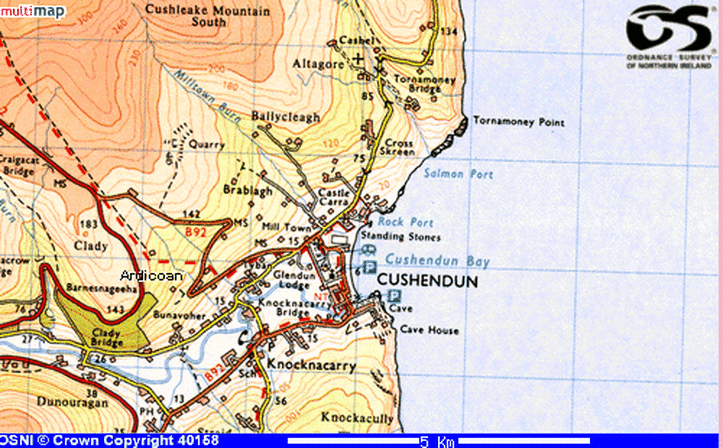BlogStories, Research & Projects
|
|
John McCambridge (aka. Seán Mac Ambróis) had a passionate interest in the Irish language, which was spoken by most of the natives in the Glens in the mid-19th Century when Airdí Cuan was written. The song is named after a place near Cushendun. According to the map below, the townland of 'Ardicoan' lies between Bunavoher and Clady Bridge to the north on the Glendun Road. In many ways, the people of the Antrim coast look towards Scotland as much as to the rest of Ulster. The Scottish connection is emphasised in local surnames such as McAlister, McKay, McNeill and common forenames like Alasdair, Randal and Archie. According to researcher Seán Quinn, "traditional culture survived well in the Glens of Antrim because of their remoteness and the Irish language was spoken daily around Cushendall until the early 20th century. Féis na nGleann was founded in Glenariff in 1904 under the inspiration of the celebrated Belfast folklorist and historian F. J. Bigger. There were competitions in language, traditional music and dancing as well as athletics and hurling. The Féis was maintained by the Gaelic League (Connradh na Gaeilge) which fostered the 20th century revival of national culture throughout Ireland. This enthusiasm for traditional culture has survived into modern times, and there are many notable singers and musicians associated with this area." The townland of Ardicoan is a mile west of Cushendun, rising north from the River Dun to a height of about 500 feet. There is a multiplicity of Gaelic versions of the placename, and an equal multiplicity of interpretations: Airdí Cúing, Ard a’ Chúíng, Aird an Chúmhaing, Ard a’ Chuain, Airdí Chuain, Ard Uí Choinn. The first element, no matter how it is spelt, probably means a height. Dr Pat McKay of the Placenames Project in Queens University Belfast says that there is no authoritative version of the name, but tentatively recommends Ard a’ Chuain – the height of the harbour, or the height of the bay (Cuan in Scottish Gaelic also means the sea). Seán Mac Maoláin argues for Áird a’ Chum[h]aing (= the height of the narrow strip of land) because the townland is well back from the sea, and follows the narrow defile at the head of the glen, reminds us that the noun ‘cúng’ also means a narrow defile between two heights. The townland itself is long and narrow, and there is an Alticoan in the next glen. John McCambridge was born in 1793 in Mullarts, near Glendun, and died in 1873. He is buried in Layde churchyard between Glendun and Glenballyeamonn. His tomb is partly in Irish. McCambridge was a native of Mullarts between Cushendun and Cushendall (at the bottom of the map) and recent research suggests that he belonged to a fairly affluent Presbyterian family. The story of Airdí Cuan is told from the perspective of a Glensman who has moved over the sea to Scotland. From Ayrshire, he can still see the hills of Antrim and he longs for his home in Glendun and the beautiful hillside at Airdí Cuan. One story goes that McCambridge left his native Glendun, perhaps to escape the potato famine, and settled in Ayrshire where he ultimately died pining for the hills of home, still visible on the western horizon. Airdí Cuan tells of his love for the 'cuckoo glen'; (Glendun) and of playing hurling at Christmas on the 'white strand' (the beach at Cushendun). Another school of thought believes that, while McCambridge was considering emigrating to the Mull of Kintyre, he stood atop Ardicoan and imagined himself over in Kintyre looking back on his native soil. However, the process of writing the song made him so homesick that he decided not to go in the end, and thus spent the rest of his days in Ireland! Which of these stories is accurate (if any!), and whether or not the song is autobiographical, I'm not sure. I still have to do more research! Make sure to click play on the videos below while you're reading the song's text.
Here are a few version online. Over on Spotify, Anúna's world-shattering arrangement is well worth a listen. Below is another of my favourite versions of Airdí Cuan, recorded by Doimnic Mhic Giolla Bhríde's Cór Thaobh a' Leithid from Gaoth Dobhair in Donegal.
2 Comments
Gabriel Scally
8/3/2018 04:44:13 pm
I'm ashamed to say that although I heard this song sung many times I didn't know it originated in Glendun, despite having spent much of my youth in the Glens. Thank you for the useful and interesting history and interpretation.
Reply
Eithne O’Connell
7/7/2019 09:16:28 am
Interesting article thank you. But the translation of the chorus isntvquitece'right. You have confused the word lonndubh meaning blackbird with lonndubh meaning depression or gloom.
Reply
Leave a Reply. |
AuthorDónal Kearney Categories
All
Archives
February 2018
|

